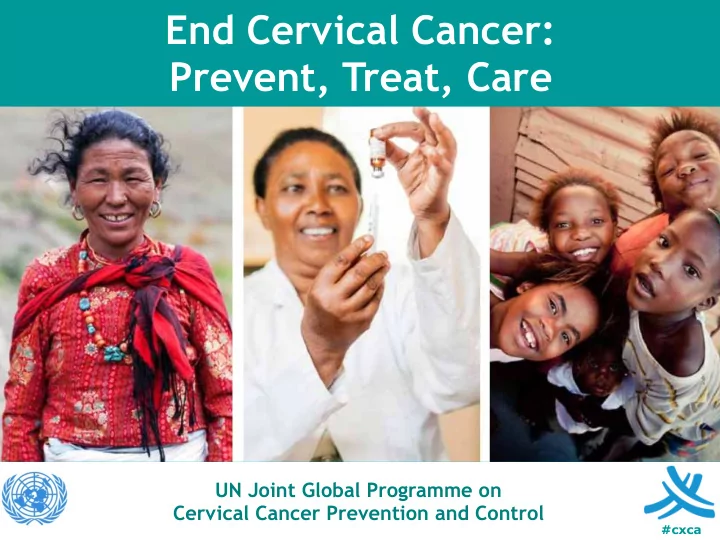

End Cervical Cancer: Prevent, Treat, Care UN Joint Global Programme on Cervical Cancer Prevention and Control #cxca
JOINT PROGRAMME MEMBERS
PRIORITIES COUNTRY LEVEL Support countries in the design and implementation of a comprehensive cervical cancer control plan, which includes all levels of prevention and treatment
PRIORITIES GLOBAL LEVEL Provide a global platform to stimulate South-South collaboration and add value to the collective effort of partners
HOW? by: Providing technical assistance to countries, assisting government to mobilize resources and joining and collaborating with domestic and international partners towards the common goal of elimination of cervical cancer
The WHO comprehensive approach to cervical cancer prevention and control: a life-course approach
Global snapshot –cervical cancer control • HPV vaccine introduction 70% of high income countries – 20% of middle income countries – 6% of low income countries – • Screening 12% of countries have screening participation rate >70% – African region 40% of countries have coverage less than 10% – • Invasive cancers Pathology services generally available in public sector – 98% of high-income countries compared to 35% in low-income countries • Treatment services available – 90% of high-income countries compared 30% of low-income countries. • 25% of countries reported having no public radiotherapy centers • Five year probability of surviving from cervical cancer – 13% in Uganda, compared to • 79% in South Korea • Palliative care through primary care 66% of high income countries – 19% of low income countries –
Country inception missions MOROCCO • Multidisciplinary national 20 Nov- 1 Dec 2016 committee MYANMAR • Introduce/scale up HPV 6- 9 March 2017 vaccination MONGOLIA • Improve screening coverage • Reduce delay in diagnosis 6-8 June 2017 and treatment UZBEKISTAN – expand treatment capacity 23-27 October 2017 • Strengthen surveillance BOLIVIA systems 27-30 November 2017 TANZANIA 4-7 December 2017
MYANMAR • To establish a National Coordination Body to oversee and coordinate cervical cancer prevention and control initiatives in the country. • To integrate HPV vaccination into the national immunization programme. • To increase cervical cancer screening participation rate from 7% to 25% by 2019 and consider integrating HPV testing in the national screening and treatment of PCL guidelines. • To improve access to cervical cancer diagnosis, treatment and palliative care in Myanmar. • To improve cervical cancer surveillance in Myanmar and eliminate lost to follow-up in the referral system. • To establish at least one population based cancer registry.
MONGOLIA Establish a national coordinating body for the Cervical Cancer • Prevention and Control Programme. Develop HPV vaccine introduction plan and secure budget for • its implementation. Revise and update the national cervical cancer screening and • treatment guidelines Consider the integration of HPV testing in the new national • guidelines. Reinforce public awareness on cervical cancer early diagnosis. • Develop human resource training plan to ensure countrywide • availability of cervical cancer control services. Reinforce the referral system. • Introduce national indicators for the cervical cancer control • programme including quality of care indicators.
UZBEKISTAN • Establish multi-disciplinary national coordination committee. • Revise the HPV vaccination plan to ensure it is updated. • Review and update national guidelines for screening and treatment. • Strengthen multi-disciplinary treatment of cervical cancer and improve referral system. • Improve the availability and consumption of oral morphine (too restrictive regulations). • Establish electronic national information system/cancer registry (currently available in hard-copy format only)
TANZANIA • To introduce and scale-up national HPV vaccination. • To strengthen existing screening and treatment of PCL services for effective secondary prevention of cervical cancer and plan for expansion. • To reduce delays in diagnosis and treatment of invasive cervical cancer aiming for the target of 90% of women with confirmed cervical cancer diagnosis starting definitive treatment within 90 days. • To support implementation of brachytherapy at Bugando Medical Centre • To strengthen cervical cancer monitoring and surveillance system.
BOLIVIA • Program plan: finalize, through a consultative process, the national cervical cancer plan • HPV vaccination: research reasons why girls are not being vaccinated and adjust delivery strategy accordingly • Screening: consider developing norms and integrating HPV testing into the screening program • Diagnosis and treatment: consider making services free of charge to eliminate financial barriers for women to be treated • Improve access to radiotherapy through replacement of LDR brachytherapy with HDR • Developing palliative care services as they are woefully lacking • Re-activate the cancer registry
Recent Progress • Expansion of partners: – GAVI, Global Fund, UNITAID , UICC, CHAI • Expansion of countries: – AFRO 10: Ghana, Guinea, Kenya, Madagascar, Malawi, Nigeria, Senegal, Sierra Leone, Zambia and Zimbabwe
PITCHING IT HIGHER • ‘Elimination of cervical cancer’ as a global goal “Elimination of cervical cancer” as global goal
Recommend
More recommend